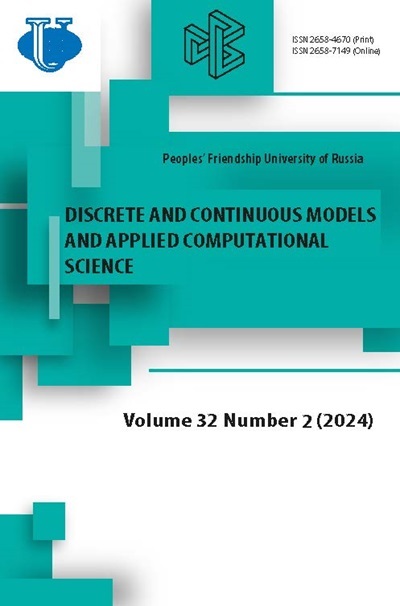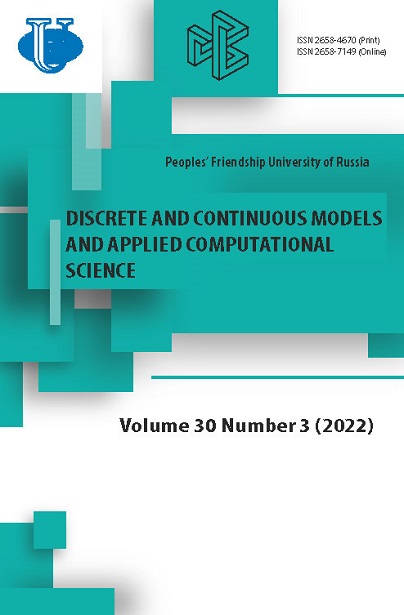О применении метода Фурье для решения задачи коррекции термографических изображений
- Авторы: Бааж О.1
-
Учреждения:
- Российский университет дружбы народов
- Выпуск: Том 30, № 3 (2022)
- Страницы: 205-216
- Раздел: Статьи
- URL: https://journals.rudn.ru/miph/article/view/32202
- DOI: https://doi.org/10.22363/2658-4670-2022-30-3-205-216
Цитировать
Полный текст
Аннотация
Работа посвящена построению вычислительных алгоритмов, реализующих метод коррекции термографических изображений. Коррекция осуществляется на основе решения некоторой некорректно поставленной смешанной задачи для уравнения Лапласа в цилиндрической области прямоугольного сечения. Эта задача соответствует задаче аналитического продолжения стационарного распределения температуры как гармонической функции с поверхности исследуемого объекта в сторону источников тепла. Цилиндрическая область ограничена произвольной поверхностью и плоскостью. На произвольной поверхности измеряется (и таким образом, задано) распределение температуры, называемое термограммой и воспроизводящее изображение внутренней тепловыделяющей структуры. На этой поверхности - границе исследуемого объекта - имеет место конвективный теплообмен с внешней средой заданной температуры, который описывается законом Ньютона. Это третье краевое условие, которое в совокупности с первым краевым условием соответствует заданию условий Коши - граничным значениям искомой функции и ее нормальной производной. Задача некорректно поставлена. В статье применением метода регуляризации Тихонова получено приближённое решение поставленной задачи, устойчивое по отношению к погрешности к данным Коши, и которое может быть использовано для построения эффективных вычислительных алгоритмов. В работе рассматриваются алгоритмы, позволяющие существенно уменьшить объем вычислений.
Об авторах
Обаида Бааж
Российский университет дружбы народов
Автор, ответственный за переписку.
Email: 1042175025@rudn.ru
ORCID iD: 0000-0003-4813-7981
postgraduate student of Nikolskiy Mathematical Institute
ул. Миклухо-Маклая, д. 6, Москва, 117198, РоссияСписок литературы
- E. F. J. Ring, “Progress in the measurement of human body temperature,” IEEE Engineering in Medicine and Biology Magazine, vol. 17, no. 4, pp. 19-24, 1998. doi: 10.1109/51.687959.
- E. Y. K. Ng and N. M. Sudarshan, “Numerical computation as a tool to aid thermographic interpretation,” Journal of Medical Engineering and Technology, vol. 25, no. 2, pp. 53-60, 2001. doi: 10.1080/03091900110043621.
- B. F. Jones and P. Plassmann, “Digital infrared thermal imaging of human skin,” IEEE Eng. in Med. Biol. Mag., vol. 21, no. 6, pp. 41-48, 2002. doi: 10.1109/memb.2002.1175137.
- G. R. Ivanitskii, “Thermovision in medicine [Teplovideniye v meditsine],” Vestnik RAN, vol. 76, no. 1, pp. 44-53, 2006, in Russian.
- A. N. Tikhonov, V. B. Glasko, O. K. Litvinenko, and V. R. Melihov, “On the continuation of the potential towards disturbing masses based on the regularization method [O prodolzhenii potentsiala v storonu vozmushchayushchih mass na osnove metoda regulyarizatsii],” Izvestiya AN SSSR. Fizika Zemli, no. 1, pp. 30-48, 1968, in Russian.
- A. N. Tikhonov and V. J. Arsenin, Methods for solving ill-posed problems [Metody resheniya nekorrektnyh zadach]. Moscow: Nauka, 1979, in Russian.
- E. B. Laneev, “Construction of a Carleman function based on the Tikhonov regularization method in an ill-posed problem for the Laplace equation,” Differential Equations, vol. 54, no. 4, pp. 476-485, 2018. doi: 10.1134/S0012266118040055.
- E. B. Laneev, N. Y. Chernikova, and O. Baaj, “Application of the minimum principle of a Tikhonov smoothing functional in the problem of processing thermographic data,” Advances in Systems Science and Applications, vol. 1, pp. 139-149, 2021. doi: 10.25728/assa.2021.21.1.1055.
- E. B. Laneev, M. N. Mouratov, and E. P. Zhidkov, “Discretization and its proof for numerical solution of a Cauchy problem for Laplace equation with inaccurately given Cauchy conditions on an inaccurately defined arbitrary surface,” Physics of Particles and Nuclei Letters, vol. 5, no. 3, pp. 164-167, 2002. doi: 10.1134/S1547477108030059.
- R. W. Hamming, Numerical methods for scientists and engineers. New York: McGraw-Hill Book Company, 1962.
- H. Pennes, “Analysis of tissue and arterial blood temperature in the resting human forearm,” J. Appl. Physiol., no. 1, pp. 93-122, 1948.
- J. P. Agnelli, A. A. Barrea, and C. V. Turner, “Tumor location and parameter estimation by thermography,” Mathematical and Computer Modelling, vol. 53, no. 7-8, pp. 1527-1534, 2011. doi: 10.1016/j.mcm.2010.04.003.
















